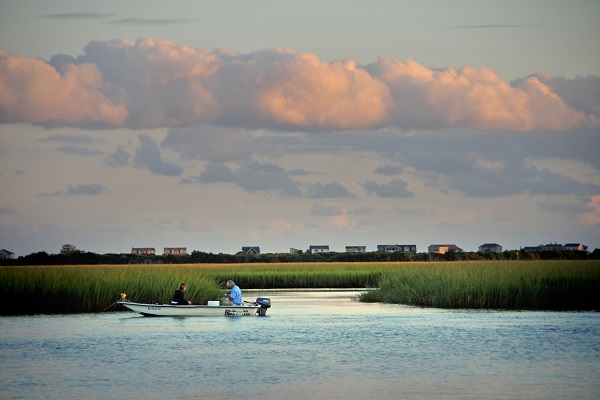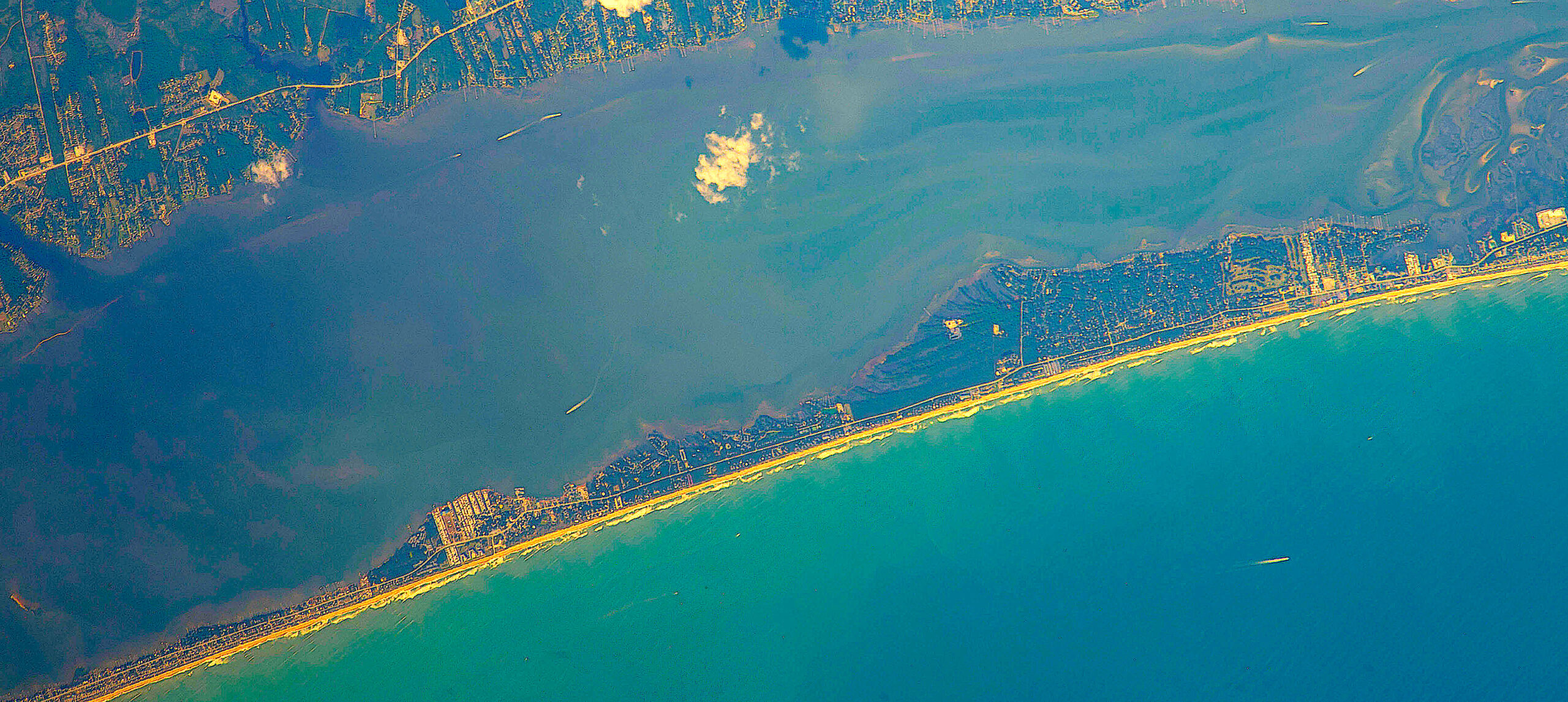Oral History: Documenting Down East Fishing Traditions

It is a breezy day on the empty dock at Clayton Fulcher Seafood Company in Atlantic. Mike Fulcher gazes inside a large room that looks bare except for a forklift and other equipment.
The pallets and scales are empty. The conveyor belts are silent. The fans and ice machine are turned off.
“We are closing down,” Fulcher says. “We are cleaning the equipment and selling it. I hate this, but we don’t have enough fishermen.”
Inside the wood-paneled office decorated with dozens of fishing photos, Fulcher recalls a time when his family fish business was thriving, with workers hauling in boatloads of shrimp, oysters, mullet and bluefish.
“This is all I have ever done,” he says while looking around at the business that his grandfather Clayton Fulcher Sr. started.
“It is hard to believe we are closing,” Mike Fulcher must sell his ice plant equipment.
Fulcher adds. “I have been here my whole Life… We have been in business for 75 to 80 years.”
Fulcher’s wife, Anne, plays with their grandson, Bodie Goodwin, who runs through the room. Fulcher feels sad that Bodie and other young Fulcher relatives won’t be able to grow up in the fish house.
Bodie loves it down here — watching people grading fish and getting ice like his father and grandfather, Fulcher adds.
PRESERVE AMERICA INITIATIVE
Fulcher’s fond memories of the seafood business are being recorded for an oral history project at the Core Sound Waterfowl Museum and Heritage Center on Markers Island.
The project is part of the Community Historians Program. The National Oceanic & Atmospheric Administration (NOAA’s) Preserve America Initiative, which helps maintain cultural and heritage resources, provided the funding.
“NOAA wanted to get information from commercial fishermen who have eyes on the water,” says Gretchen Bath Martin, research fishery biologist for NOAA National Marine Fisheries Service in Beaufort. “They have important data to share and vast ecological knowledge of the fisheries.”
After the information is recorded, it will be used as audio and text in exhibits that highlight NOAA photos and charts at the museum. “This is work that we have wanted to concentrate on for years,” says museum director Karen Amspacher.
“Now with NOAA’s help, we can bring together all that has been done and much of what needs to be done to archive and make public this important piece of Down East Carteret County’s history for the future.”
For the oral history project, volunteers attended training sessions with Carteret County musician and folklorist Connie Mason. Oral histories often contain information not available in other historical records, and enrich written history with human feelings and personal accounts of events.
“We are in a period of rapid fire change,” Mason says. “We are creating a database for future historians and documenting the culture that we are losing.”
Across the country, there is an increased interest in oral history from museum curators to lay historians.
“Oral history has earned its stripes, you might say, among the community of academic historians,” according to a 2004 report of the Southern Oral History Program. “Teachers also have found that oral history is a good tool for quickening the historical interests of their students.”
For the museum project, many volunteers have strong ties to the history of Carteret County.
The workshop also attracted people from other areas, including Farmville in Pitt County. “I am a local history buff and want to start my own community night in Farmville,” says Donna Kemp, publisher of The Farmville Enterprise. “I want to interview tobacco farmers about the culture in Farmville.”
COMMUNITY INTERVIEWS
For the project, volunteers, as well as professionals, are interviewing a variety of Carteret County residents, including commercial fishers, fish house owners and others.
The project includes the oral history of researchers from the federal lab in Beaufort established at the Bureau of Commercial Fisheries in 1899. Later it became a National Marine Fisheries (NMFS) lab. Now, it is a joint NOAA/National Ocean Service and NMFS Lab.
“Through the years, many scientists at the Beaufort Lab have been intimately involved in not only local fisheries research, but also were active commercial fishermen and had a strong presence in the Down East community, whether by family ties or love of the people and the environment,” says Martin.
Volunteer Laura Southwood will be talking to Frankie Guthrie, who grew up in the fishing community of Atlantic and married into a Barkers Island fishing family.
Frankie knows all about the island’s history and all the changes, as well as the different generations of fishermen, according to Southwood.
Photographer and artist Susan Mason interviewed several Down East natives, including netmaker Heidi Harris whose father, Roger Harris Sr., started a net shop in Atlantic. “Heidi told me that making nets is like making a dress using a pattern,” Mason adds. “She cuts out pieces of net and pieces them together.”
Heidi offered a female perspective but gave some of the same reasons as men for why the fishing industry is fading, Mason explains.
She also recorded the oral history of commercial fisherman Jonathan Robinson who serves as a Carteret County commissioner.
“When I played back my interview with Jonathan at the training session, people were moved to tears.” she says. “Jonathan spoke about the camaraderie in long hauling…”
“He said: ‘Even though you’re out there competing together, there’s a certain amount of camaraderie and sharing of information. I’ve seen a lot of people throw down a day’s work to give somebody a hand working on an engine or a net or towing somebody back in. I don’t think they do that on Wall Street.'”
The interview brought back memories of Mason’s late brother, Thomas Mason, who had a long history as a commercial fisherman in Atlantic.
“Thomas worked so hard,” says Mason. “His hands and feet were so scarred and swollen from fishing… He used to physically pull Ms nets before he got a reel. I watched him often. It was like watching a dance.”
Because Mason just moved back to Atlantic after a long teaching tenure in Alaska, she says the interviews gave her new ties and insight into what the commercial fishing community is like now.
“For so long, it was our culture,” she says. “Everyone realizes it is changing, and everyone is uncertain about what’s to come.”
FISH HOUSE HISTORY
With the demise of commercial fishing, many fish houses are going out of business.
To preserve the long legacy of seafood businesses, Carteret Community College instructor Ruth King got together the Fulcher family from Atlantic.
“I have been friends with the Fulchers for several years,” King says. ‘This business is closing. I can relate to them losing their livelihood and history because I come from a tobacco family.”
To find out about the Fulchers’ colorful history in the seafood business, King sat down in the tiny office with two generations, including Mike Fulcher and his father, Harry B., as well as his brother, Tommy, cousin Clay, and his uncle’s wife, Iris.
Clay Fulcher says that his grandfather, Clayton Fulcher Sr., started out as a pound netter and opened his first fish house in the 1930s in Bayboro, and then branched out to Atlantic and other areas.
He probably had six or seven boats that picked up the catch from the crews, Clay adds. At one point, his granddaddy was buying from 15 different stations and had boats to Ocracoke and Hatteras.
As the seafood business grew, Clay’s grandfather replaced the run boats with trawlers.
Throughout these years, Clay says the size of the fish harvests varied from season to season.
“The fishing ran in cycles,” he adds. “There were years when there was not much production, and then it came back.”
When his grandfather developed asthma, Clay’s father’s, Clayton Fulcher Jr., took over and designed a logo with “Diamond Shoals #8” for shipping fresh and frozen oysters.
The number 8 stands for the N.C. shellfish license, one of the earlier numbers in the fishing business, he explains.
Clay says they had a large shucking room for oysters. “There would sometimes be 25 workers at a time,” he adds. “If a boy wanted to work, he came to the fish house. Women were a huge part in the labor force.”
INDUSTRY MECHANIZATION
During the 1950s, the family began to mechanize the business. First, they replaced the wooden floors with concrete so workers could operate forklifts. Later, they added conveyor belts.
In 1954, Hurricane Hazel — a Category 4 storm — hit the area and destroyed the Fulchers’ oyster shucking house on Lewis Creek.
“We lost 10,000 bushels of oysters that were sanded up from Hazel,” says Clay.
Throughout the 1960s and 1970s, the fishing business prospered, and other family members joined the business.
“When I was big enough to do anything, I dragged baskets of fish,” Mike says. “I was probably in the sixth grade. I have a lot of childhood memories. There was a lot of joking and hard work.”
During this time, the seafood business peaked.
“In the late 1970s, there were 17 or 18 fish houses in this area,” Tommy Fulcher says. “Today, there are only five fish houses from Cedar Island to Harkers Island.”
In the 1970s, federal and state regulations increased, but the seafood business continued to thrive until 1995.
Tommy says that the rules and regulations as well as pollution contributed to the industry’s eventual decline, and foreign imports also have hurt the business.
“Fishermen have had to quit because they can’t diversify,” he adds.
After the interview, King follows the family throughout the fish house with a video camera.
First, Clay shows a photo of his grandfather. “His eyes follow you everywhere in the room,” he says.
Then Clay and Mike go outside to the dock overlooking Core Sound. Clay points out where the Old Drum Inlet on Core Banks was before a storm closed it. Then he shows where an old shrimp house stood before it burned to the ground.
“There used to be a lot of wooden houses here,” he adds.
At the end of the dock, the two men head into an old building where workers shucked oysters and headed shrimp.
“We used to have 50 people in here,” Clay says. “There were benches on each side for heading shrimp. Each person had a bucket.”
The tails were dropped into a water trough that carried them to a grading machine, he adds. Because the shrimp heads were not sold, they were frozen or tossed.
Further back, he shows a room where up to 45 people would shuck oysters at one time. “As things changed, we used just one side,” he adds. “At the end of the first room, we used to grade clams.”
The Fulchers then step inside a large concrete building where workers would sort, weigh, box and refrigerate seafood.
“As of October 2006, we cut off the refrigeration and ice machines,” he says of the empty room.
On the floor, there are some pools of water, and a few boxes stacked up. “These boxes were used to freeze spot,” Clay adds.
A nearby building was an ice plant. He points out the huge ammonia compressors that were used before Freon to make ice.
“The tanks have been removed where workers made blocked ice,” adds Clay. “There used to be big steel cans that held up 300 pounds.”
In 1970, they bought machines to make small cubes of ice.
“It is a shame we are closing,” he says. “At one point, we had six people running the ice plant. In the mid-’80s, we had probably 30 employees all together, and 10 or 15 workers who stayed in a bunk room here in the plant.”
To find out more about the NOAA Preserve America Initiative, visit the Web: preserveamerica.noaa.gov.
To learn more about the Core Sound Waterfowl Museum, go online to www.coresound.com/.
This article was published in the High Season 2007 issue of Coastwatch.
For contact information and reprint requests, visit ncseagrant.ncsu.edu/coastwatch/contact/.


